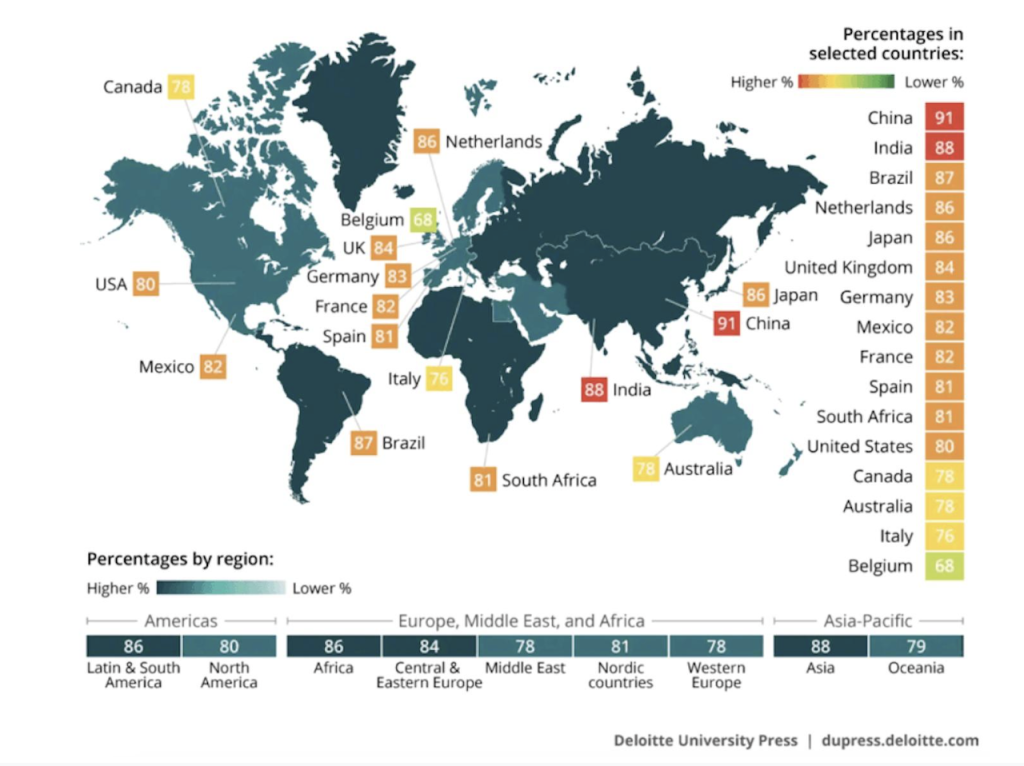We are in the middle of the Fourth Industrial Revolution.
The term was first coined in 2016 by World Economic Forum founder Klaus Schwab, referring to a period of extraordinary technological advancements that will herald fundamental changes to how we work, live, and relate to each other.
But while it’s difficult to predict exactly how our personal lives might change in the next decade, the impact of new technology on work and employment is more apparent than ever.
There’s an employment shortfall coming. A 2020 World Economic Forum report estimated that by 2025, we’ll no longer need 85 million jobs as technology continues to shift the division of labor between man and machine. The same report says that as many as 133 million new jobs could also be created, requiring more than half of all employees to update their existing skills or learn new ones to meet emerging demands.
Constant change requires constant updates.
Rapid advancements in big data, machine learning, artificial intelligence, and market analytics are altering how businesses operate. Virtually every sector is going through a transformation, with vast numbers of existing employees needing reskilling or upskilling to keep up with the changes.
IBM research has found that the half-life of professional skills has dropped from 10 to 5 years, with technical skills further halved to 2.5.
This means cutting-edge skills today will be half as valuable in two and a half years, emphasizing the need for continuous learning.
A 2021 McKinsey survey found that 70% of businesses are doing more skill-building now than before the pandemic. Research by Deloitte on employment trends shows that continuous learning is considered ‘important’ or ‘very important’ for business success in virtually every part of the world.

Upskilling and reskilling programs offer individuals an opportunity to get ahead of the curve by equipping themselves with new skills that will ensure they stay relevant in the new paradigm of Industry 4.0.
Table of Contents
What do reskilling and upskilling mean?
What are the benefits of reskilling and upskilling?
How to identify skill gaps?
How to find the right reskilling or upskilling programs?
What do reskilling and upskilling mean?
The terms’ reskilling’ and ‘upskilling’ refer to when someone learns new skills to ‘future-proof’ their talents. However, understanding the differences between the two is vital in determining whether reskilling or upskilling programs will benefit an individual or company.
Reskilling
Reskilling involves training to learn new or adjacent basic skills to do a different job. As technology creates new roles, reskilling becomes paramount in keeping up with changes and staying relevant. Reskilling often results in lateral moves within a company as old jobs become obsolete and positions requiring new skills are created.
This type of training is particularly crucial for people with jobs whose demand is steeply declining. For example, those in traditional sales might get digital analytics training to adapt to the changes in the marketing landscape.
Upskilling
In comparison, upskilling is when someone looks to update or advance an existing skill set to further their abilities in a specific field. Upskilling is often associated with linear growth inside an organization and is critical in reaching higher proficiency levels. For instance, a software programmer might take an upskilling course to learn about machine learning algorithms, extending their knowledge and programming expertise.
The benefits of reskilling and upskilling
Reskilling teaches in-demand skills that close skill gaps and qualify you for hundreds of newly-created positions. Reskilling programs also help you move laterally within a company when a particular role is being phased out.
Upskilling keeps you at the top of your field by promoting professional development. As technology evolves and old business methods become outdated, companies need experts who have updated their skills to handle the changes effectively. Upskilling programs make already-skilled individuals highly employable and are critical for career development.
Additionally, offering reskilling and upskilling programs has several cascading benefits for businesses and companies as a whole:
- Better Morale
- Easier recruitment
- Employee retention
- Employee satisfaction
- Increased productivity
- Improved corporate reputation
Research has found that learning and development programs are critical for internal mobility and job satisfaction, with 86% of CEOs reporting that launching digital training and education programs improved employee engagement.
A 2021 LinkedIn survey saw employees overwhelmingly rating ‘learning’ as the number one marker of an exceptional workplace, echoing findings of earlier research that showed 94% of workers would stay at their jobs longer if it offered upskilling opportunities.

Understanding Your Skills
Before you can decide which reskilling or upskilling programs to take, it’s important to first asses your current skill sets and identify specific areas of growth.
Assessing your skills — what do you already know?
The first step is figuring out your capabilities on different metrics. This will allow you to identify realistic growth areas and create customized learning plans. For example, you can create a simple skills matrix to assess your level of proficiency in the following:
- Sales
- Data analysis
- Graphic design
- Technical skills
- Communication
- Project management
- Problem-solving skills
The more specific you are about your abilities and degree of proficiency, the easier it is to identify which areas to focus on.
Identifying skill gaps — what should your learning emphasize?
Becoming skilled at everything is impossible, so identifying specific knowledge gaps will help you determine whether reskilling or upskilling — and what kind — will benefit you most.
You can research a specific sector or company’s operations to see their services and the necessary new skills required. Reading posted job descriptions and related skills is another good way to identify where to seek training to bridge skills gaps.
Finding the right program
Online training programs had gained plenty of momentum before 2020, but one of the things the pandemic made abundantly clear for everyone is the incredible value and efficiency of eLearning.
Today, thousands of online programs, courses, and certifications are available; especially ones focused on bridging skill gaps by reskilling and upskilling workers.
Four common areas where you can find a reskilling or upskilling program are:
- Analytics
- Leadership
- Digital Marketing
- Technical knowledge
Here are some things to keep in mind when trying to find the right program:
Do the research
After identifying where to focus your training, it’s time to research companies, universities, or institutes that offer training programs to help bridge the knowledge gap. This is a critical step, as only certain programs will apply to your needs or situation.
Assess the program
Once you’ve found something suitable, you need to assess the program’s quality by reading reviews, looking at enrolment numbers, and finding out what percentage of graduates reach their career goals after the program. Programs that offer continued support are the most beneficial.
Evaluate your options
Finally, there are other things to consider, like costs and a program’s required time commitment. Some people will need more flexibility or will have more restrictive budgets.
While upskilling and reskilling programs are undoubtedly worthwhile future investments, your time and financial situation will play a factor in your choices.

Choose Pathstream
Pathstream is a frontline career mobility platform that helps you check all the boxes.
We’ve identified today’s high-demand digital skills careers and have partnered with universities and tech companies to offer focused, affordable certifications that meet those needs. 97% of our graduates find work in their desired career within one year of program completion. Our upskilling and reskilling programs include:
- Data analytics: The Tableau Data Analytics Certificate focuses on large data collection and analysis, improving data science and analytics skills to understand performance and identify improvement metrics.
- Sales administration: The Salesforce Admin Career Certificate teaches customer relationship management (CRM) and trains you on Salesforce roles. Additionally, it cross-trains marketing teams on some technical matters to increase background knowledge and help with sales and product launches.
- Project management: The Asana Project Management Certificate teaches effective leadership, project management, and delegation. The program also teaches soft skills like communication, problem-solving, critical thinking, and employee engagement to increase productivity and output.
- Digital marketing and design: The Facebook Digital Marketing Certificate focuses on a range of in-demand digital marketing and design skills to help modernize business operations. The program covers digital upskilling, including programming skills, learning new software, and launching marketing campaigns.
The Bottom Line
Our future success depends on whether we adapt to the tides of change or be dragged down by them.
Let’s review some key points:
- Technological advancements have reached a new evolutionary paradigm.
- Keeping up with the pace of technology is at the forefront of business needs.
- Continued and rapid digital integration is inevitable, soon to make tens of millions of jobs obsolete.
- More than half the workforce will need reskilling and upskilling to meet new demands.
- Upskilling and reskilling ensure you stay employable and relevant in the future job market.
- Assessing skills and identifying knowledge gaps should come first..
- Researching, evaluating, and choosing the right reskilling and upskilling programs are crucial.
What’s the first step?
The first step is deciding to take charge of your future, not the other way around.
The hypotheses of the previous decade have proven to be the realities of today as more people notice fundamental changes to the way they work. And it’s up to us — individuals and businesses — to prepare ourselves for the changes that have already begun.
Fortune 500 companies like Google, Amazon, and Walmart are already leading the way. By providing employees with reskilling and upskilling programs, these business giants are investing in themselves to create tomorrow’s future-ready talent.
Soon, everyone will follow their example.
Through partnerships with employers, software companies, and universities, Pathstream offers programs that directly meet the needs of current job trends.
Whether that means learning new skills, updating existing ones, or upskilling employees to future-fit your existing workforce, there’s still time to get ahead of the curve.
Was this helpful?
Thanks! What made it helpful?
How could we improve this post?






